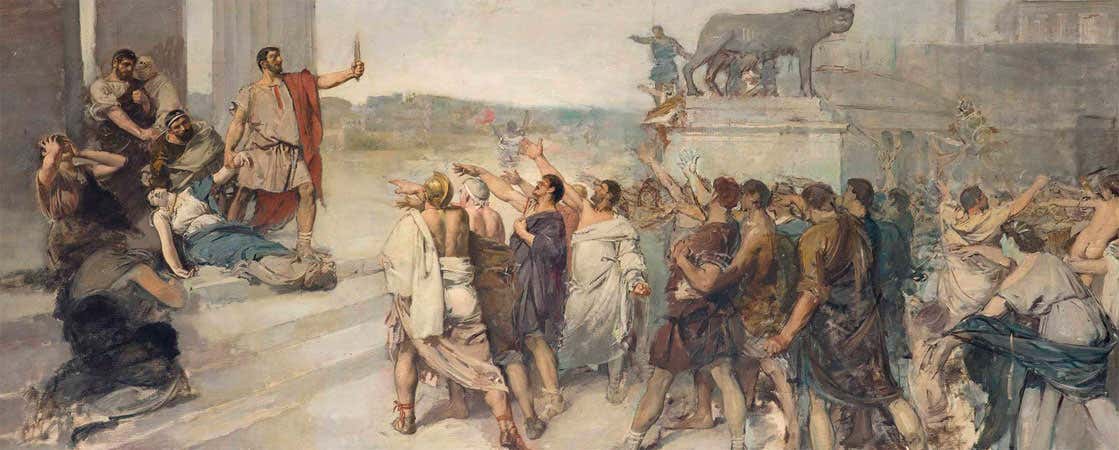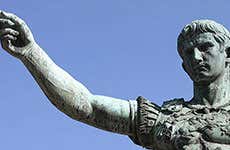
Roman Republic (509 BC - 27 BC)
The Roman Republic was installed after the Roman kingdom was overthrown in 509 BC and lasted until 27 BC. One of the most important figures of this period is Julius Caesar.
According to tradition, in 509 BC a series of essential events took place in the history of Rome: the last monarch was expelled, Rome was taken by Porsenna's army, the treaty between Rome and Carthage was signed, the Consular Fasti began and the temple of Jupiter Capitolinus was consecrated. It seems like a lot of events for such a short time. The only one that belongs with certainty to the year 509 BC is the dedication of the temple of Jupiter. The other events may have taken place later, albeit within a short period of time.
The Fasti consulares (documents with the names of the consuls or magistrates that described the main events of the period) are essential for understanding the Roman Republic from 503 BC, from when they are considered credible.
Another very important method used to understand this period of Roman history is the ritual of the clavus annalis. This practice began one year after the temple of Jupiter Capitolinus was consecrated and it consisted in fixing a bronze nail to the right of the altar once a year. The first nail was placed in 508 BC. The temple of Jupiter Capitolinus had the cella of Jupiter, as well as the cella of Minerva and Juno.
The decade after 509 BC (the year when the last King of Rome was dethroned, while he was away from Rome) is a dark period and very little is known, only isolated events.
Transition to the Roman Republic
The transition of Rome from a monarchy to a republic led to severe internal social tensions. This lack of control over the city led neighbouring tribes to siege the city and reduce its power. This is why Rome had to ratify its identity on numerous occasions during the first 70 years of the Republic.
The early years of the Republic are of political turmoil. The population was divided, certain wanted a monarchy, others a republic, others favoured the king of Clusium, Lars Porsenna, and others wanted to form part of the Latin civilisation. The nobles who had overthrown the king and his family had not come to an agreement regarding the type of government that would replace the monarchy.
The consuls, which would later replace the leadership of the Roman kings, were not put in place immediately, but many years later.
Many historians believe that in the first stages of the Roman Republic, a praetor maximus was appointed for one year only. Later his duties would be split in two by choosing two consuls at a time to govern Rome. This form of government went on until 449 BC, with the Valeria Horaria law.
The position of chief magistrate was not exclusively for the “patres”, who formed the Roman senate, and controlled the army and the priests since the time of Romulus, as there is evidence that shows plebeians, common civilians, becoming consuls up until 485 BC. The political instability led the strongest factions to form alliances between themselves.
From 485 BC, the patricians no longer allowed commoners to take part in the government and began to control all civil and religious matters.
Roman Law
As well as the constant rivalry between patricians and plebeians, the Republic is also known as a period in which the power of Rome reached the whole peninsula of Italy and Roman law was founded with the Law of the Twelve Tables in 450 BC. Moreover, it was also a period when many wars took place for equality between the Roman inhabitants. The Twelve Tables were written up to appease the demands of the commoners.
Until the Tables were written, Roman law had had a sacred character, as it had been linked to the monarchy and the college of pontiffs. With its drafting, Roman law was desacralised and became the basis of the law of the Western world. According to the historian Titus Livy, the Twelve Tables were the source of all Roman law, both public and private.
Between the years 133 BC and 27 BC, Rome suffered from great internal tensions, leading to numerous civil wars. The Graco brothers, who proposed a series of laws in favour of the plebeians, also led to a social crisis in Rome.
Dictatorship: Transition from the Republic to the Roman Empire
The big step towards a political system in which power was accumulated in the hands of a single person was taken by Sulla (dictator in the years 82-79). Sulla's systematisation was very important and one of the consequences, which greatly influenced politics and the very end of the Republic, was the fact that he concentrated all political power in the hands of the Senate, which was not the case with the executive government.
This meant that the Senate had to entrust the executive to a natural-born leader, a general who was also a politician. At the same time, the Populares also wanted to occupy power, leading to a strengthening of personal power in governing. The strengthening of personalism led to the triumvirate and the dictatorships of Julius Caesar or Augustus and marked the end of the Republic and the beginning of a new era, the Empire.

